How balanced water chemistry can help prevent further algae growth
by arslan_ahmed | May 5, 2023 12:00 pm
By Terry Arko 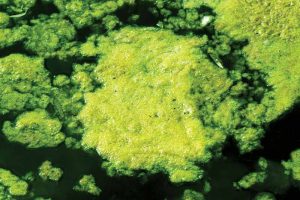 [1]
[1]
Scientific studies estimate there are 30,000 to one million different species of algae in existence.1 There are also several thousands of species which have yet to be classified or named. It appears even phycologists, the people who study these organisms, disagree on the exact number of known and unknown species of algae. In pools, four main types—green, yellow, blue-green, and black—are typically identified as unwanted invaders. Since these species are omnipresent, especially in the outdoor environment, keeping them out of the pool is nearly impossible. Therefore, it is paramount for the water chemistry to be balanced, to ensure algae cannot bloom.2, 3
Chlorine and pH for algae control
One of the best algae preventers and algaecides is chlorine.4 More specifically, free chlorine (FC), and even more specifically, hypochlorous acid (HOCl). It takes just 0.05 parts per million (ppm) of HOCl to effectively prevent and inactivate algae in pool water.5 FC consists of both HOCl and hypochlorite ions (OCl-). HOCl is 99 per cent effective at killing algae, while OCl- is only one per cent effective. To ensure proper prevention and killing of algae in pool water, there must be a sufficient amount of HOCl. The pH and temperature of the water play an important role in the production of HOCl. In a pool with a pH of 7.5 and a temperature of 30 C (86 F), there is 50 per cent HOCl and 50 per cent OCl-. In this case, there would be no cyanuric acid (CYA) present, so there would be more than enough HOCl to keep algae out, at FC levels of 1 to 4 ppm. If the pH were to rise to 8.0 in this particular pool, the HOCl would go down to 24 per cent. As a result, the FC levels would need to be 3 to 4 ppm to keep algae out. Evidently, there is more algae-fighting power from chlorine at a lower pH.6
What happens when CYA is added?
If CYA is added at a level of 30 ppm, conditions change considerably, and maintaining an FC level of 1 to 4 ppm may not be sufficient to keep algae from blooming. Here is why: in a pool with 30 ppm of CYA and a pH of 7.5, there will still be 50 per cent HOCl and 50 per cent OCl- as FC. However, 97 per cent of the FC is bound to the CYA, and only three per cent of the FC is available to disinfect and control the algae. In this case, if one takes three per cent and divides it by two, they will get 1.5 per cent active HOCl and 1.5 per cent active OCl-. The following example shows the effect CYA has on chlorine’s ability to prevent algae at FC levels of 1 to 4 ppm. Ultimately, at least 0.05 ppm of HOCl is needed to prevent algae.7

As CYA levels increase, more chlorine will be needed to create the sufficient level of HOCl required to keep algae from growing. In this scenario, pH is still important; maintaining a lower pH will help to provide a higher percentage of HOCl. With a pH of 8.0 and a CYA level of 30 ppm, there will be a 15 per cent reduction of HOCl in the water. This means the pool would have to be maintained at no less than 4 ppm of FC to keep algae out. In contrast, if the pH were lowered to 7.3, there would be more than a sufficient amount of HOCl at just 2 ppm to kill and prevent algae. Managing both pH and CYA is an important step toward keeping algae from blooming in the pool.
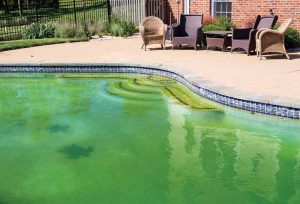 [2]
[2]Controlling nutrients in pool water
Algae is a plant, and like most plants, it needs nutrients to bloom. The two main nutrients it needs are nitrates and phosphates.
Nitrogen is introduced from lightning and rainstorms, as well as from swimmer waste and well water. At proper levels of FC, nitrogen in the form of nitrites will be oxidized out of the water. If the FC level is too low, nitrites will convert to nitrates, which cannot be oxidized and will accumulate as food for algae. Algae can become a problem at nitrate levels of 10 ppm. Nitrates can only be removed by draining some of the water out to lower the ppm level.
Another prime nutrient for algae growth is phosphate, in the form of orthophosphate. Phosphates are introduced to pool water from many sources. The two main contributors of phosphate are metal sequestering products used to prevent scale and staining, and source fill water. Many metal and scale prevention products contain phosphonic and phosphoric acid. While these are not direct nutrients, their reaction to metals and hydrolysis will produce orthophosphate, which is a direct nutrient. The biggest culprit of this nutrient is source water.
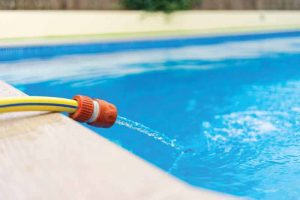 [3]
[3]A majority of water treatment facilities in North America are mandated by the Environmental Protection Agency (EPA) to practise corrosion control of underground pipes, to prevent the leaching of lead or pathogenic micro-organisms into the supply chain. As a result, straight orthophosphate is added to drinking water systems as an anti-corrosion method for lead and copper, as recommended by the EPA.8
One way to determine the presence of orthophosphate in fill water is to test the source. Most test kits and strips in the pool industry are designed to check for this direct nutrient. To take this a step further, orthophosphate is classified as a “growth limiting nutrient” for algae, according to lake and pond science. This means the presence of orthophosphate in water is crucial to the healthy growth of algae. When orthophosphate is removed from the water, even if there are still nitrates present, the growth of the algae is seriously limited.9 However, phosphate can be placed back into the pool as a result of refilling. Thus, it is recommended to test the source water and pool water, then treat the pool water with a phosphate remover. Zero phosphate would be ideal. However, in today’s world, it would be very difficult. It is best to maintain a phosphate level below 200 parts per billion (ppb).
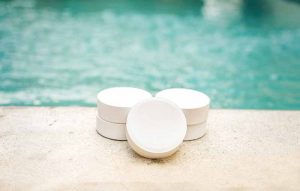 [4]
[4]Managing nitrates and phosphates and keeping their levels down will go a long way, not only in preventing algae, but also in saving chlorine. One of the biggest consumers of free chlorine is algae that continues to feed on nutrients.10
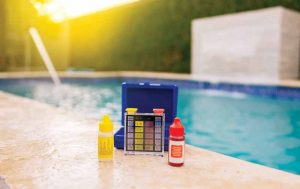 [5]
[5]How borates prevent algae growth
An effective way to control algae is by adding borates to the pool. At a level of 50 ppm, they will help reduce algae’s ability to grow. However, it should be understood the borates will not kill existing algae which has already bloomed. Borates are considered algaestats rather than algaecides. While they cannot affect bloomed algae, they act as inhibitors to prevent cell wall development, metabolism, and cell division. If left unchecked, algae cells have the ability to divide and double in population within three to eight hours. If the algae is allowed to reach this stage, it will consume chlorine and visible algae will appear. Since borates prevent the cell division process, algae cannot grow or consume the chlorine in the pool water. Borates also act as a buffer to prevent the pH from increasing. If the pH is controlled, it will be harder for algae to grow. In addition, because borates help soften the water, chlorine and algaecides can more easily penetrate any algae spores.
The optimal and most cost-effective type of borate product is boric acid. It takes 21.5 kg (47.5 lb) of boric acid to get 50 ppm in a 75,708.2-L (20,000-gal) pool.11
Some of the best water quality practices to help reduce the potential for algae include:
- Maintaining a pH of 7.2 to 7.5 (the lower
the better). - Keeping a CYA level of no more than 30 ppm.
- Ensuring phosphates remain below 200 ppb.
- Managing nitrates to less than 10 ppm.
- Adding borates at level of 50 ppm.
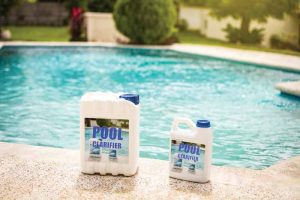 [6]
[6]Algaecides can also be used and are recommended during warm weather conditions and heavy swimming seasons. Polyquat is one of the best algae preventors, and is ideal for the prevention of green, free-floating algae. Copper-based algaecides are effective against blue-green forms of cyanobacteria, black algae, and yellow algae. As long as the pH of the water remains balanced, staining from metallic algaecide should not be a problem. There are also products which incorporate the use of sodium ammonium combined with chlorine, to bring the pool from green back to blue within 24 hours. While these additional tools will help keep algae out of pools, good water quality practices and regular brushing are still the best foundational routines for prevention.12, 13
Notes
1 Read How Many Species of Algae Are There? Phycological Society of America, 2012.
2 Refer to Service Tech Manual, Pool and Hot Tub Alliance (PHTA), 2019.
3 See ABCs of Algae, PHTA Recreational Water Air Quality Committee, 2018 Tech Notes, AQUA Magazine.
4 Consult AquaTech Best Practices for Pool and Aquatic Facility Operators, Human Kinetics, Inc., 2008.
5 See Pool Chemistry for Residential Pools, Lowry Consulting Group, LLC, 2018.
6 Refer to White’s Handbook of Chlorination and Alternative Disinfectants, 5th Edition, John Wiley and Sons, Inc., 2010.
7 See note 5.
8 Refer to Optimal Corrosion Control Treatment Evaluation Technical Recommendations for Primacy Agencies and Public Water Systems, United States Environmental Protection Agency (EPA), 2016.
9 Consult Management of Phosphates in Recreational Waters for Optimum Algae Control, by Everett Nichols, PhD, Proceedings Vol. III, NSPI Chemistry Symposium, 1998.
10 See note 9.
11 See note 5.
12 Read Swimming Pool Care “The Essential Guide,” David Van Brunt, 2018.
13 Consult Pool and Spa Operator Handbook, Pool and Hot Tub Alliance (PHTA), 2017.
 Author
Author
Terry Arko is a product training and content manager for HASA Pool Inc., a manufacturer and distributor of pool and spa water treatment products in Saugus, California. He has more than 40 years’ experience in the pool and spa/hot tub industry, working in service, repair, retail sales, chemical manufacturing, technical service, commercial sales, and product development. He has written more than 100 published articles on water chemistry and has been an instructor of water chemistry courses for more than 25 years. Arko serves as a voting member on the board of the Recreational Water Quality Committee (RWQC). He is a commercial pool operator (CPO) course instructor, a teacher of the Pool Chemistry Certified Residential course for the Pool Chemistry Training Institute (PCTI), a California Pool and Spa Association (CPSA) board member, and a member of Pool & Spa Marketing’s editorial advisory committee. He can be reached via email at terryarko@hasapool.com.
- [Image]: https://www.poolspamarketing.com/wp-content/uploads/2023/04/bigstock-Green-Algae-3530572.jpg
- [Image]: https://www.poolspamarketing.com/wp-content/uploads/2023/04/bigstock-Filthy-Backyard-Swimming-Pool-45958981.jpg
- [Image]: https://www.poolspamarketing.com/wp-content/uploads/2023/04/bigstock-Swimming-Pool-Being-Filled-Wit-462157879.jpg
- [Image]: https://www.poolspamarketing.com/wp-content/uploads/2023/04/bigstock-Close-up-Of-Some-Chlorine-Tabl-455029175.jpg
- [Image]: https://www.poolspamarketing.com/wp-content/uploads/2023/04/bigstock-Mini-Tester-For-Pool-Maintenan-470216795.jpg
- [Image]: https://www.poolspamarketing.com/wp-content/uploads/2023/04/bigstock-Algaecide-Clarifier-Homemade-S-456962241.jpg
Source URL: https://www.poolspamarketing.com/trade/features/how-balanced-water-chemistry-can-help-prevent-further-algae-growth/